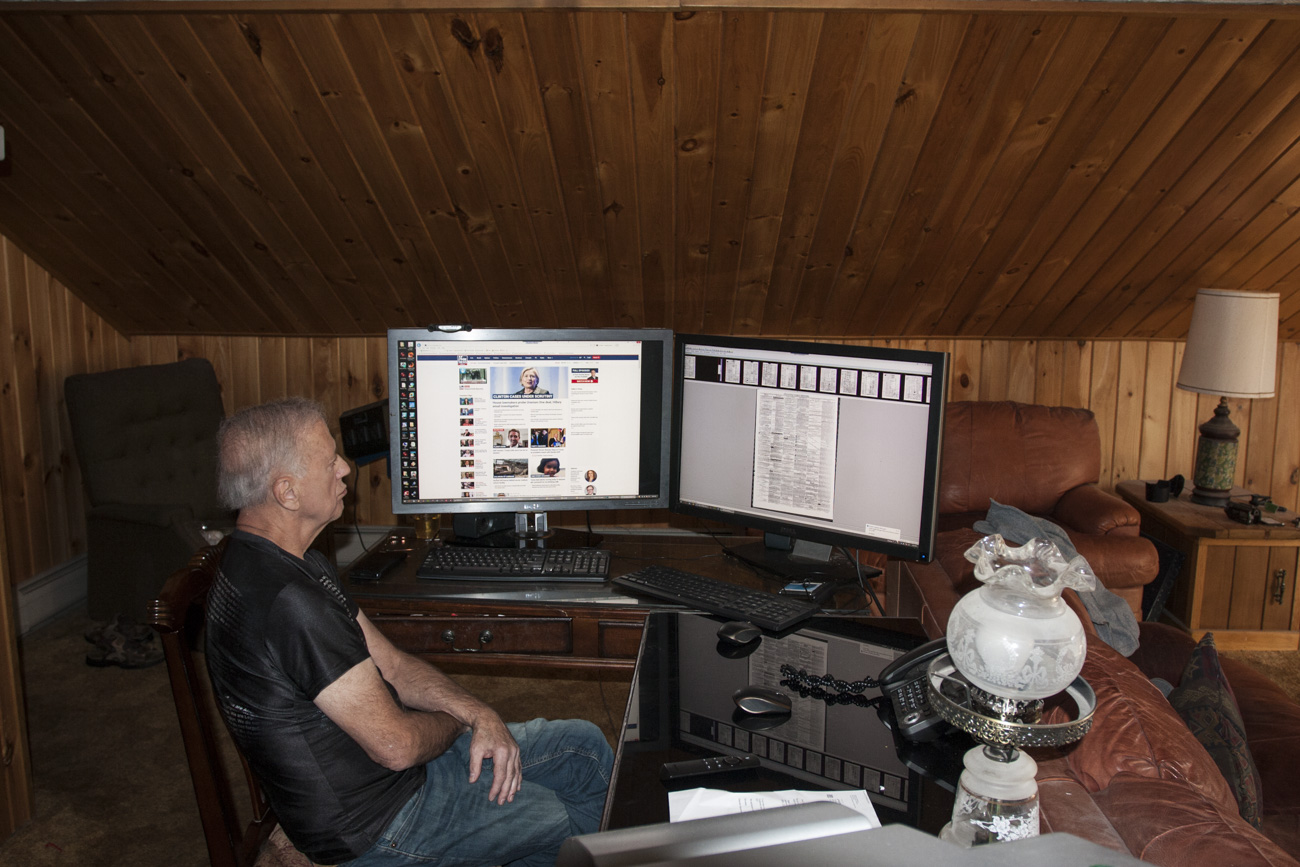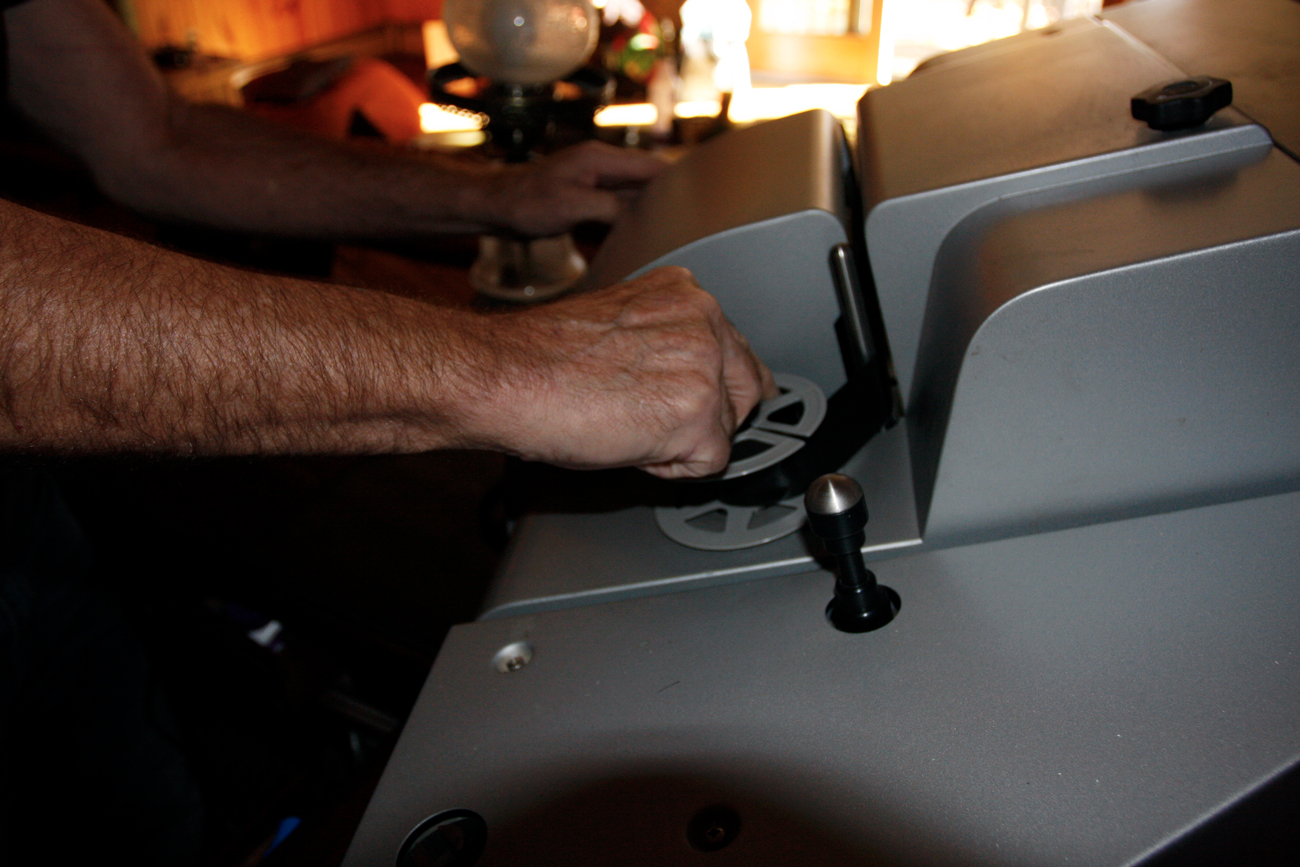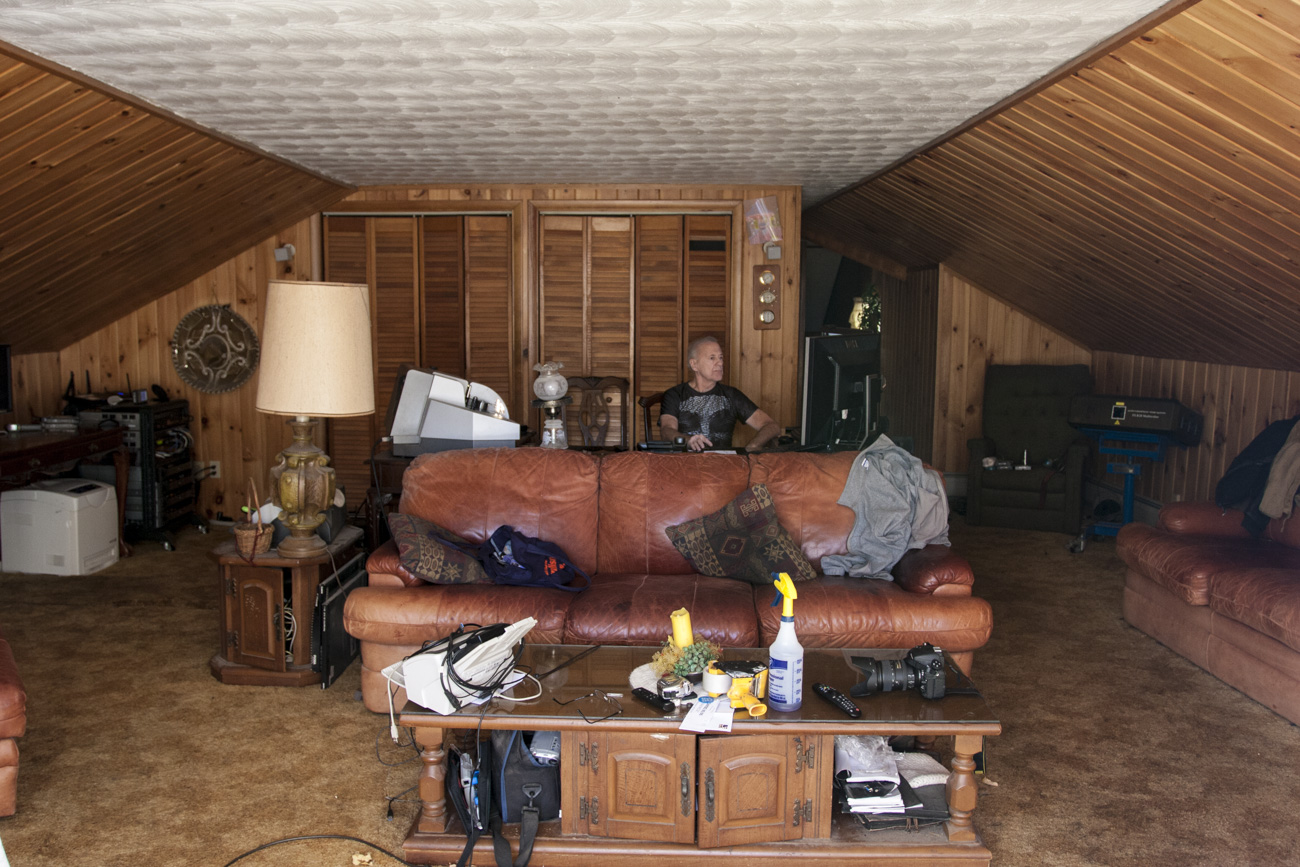Sign up for the daily CJR newsletter.
Tom Tryniski does not lock his doors. He spends most days sitting in his living room in Fulton, New York, 30 miles northwest of Syracuse, in front of two jumbo computer monitors, looking something like a security guard, but friendlier. He appears young for 68—skinny, with a head of white hair and an energetic demeanor. He wears a uniform of jeans and a slim-fitting T-shirt, but no coat in the chilly fall air. When we talk, he is almost always smirking.
There are few newspapers left in his community; the Fulton Patriot closed in 2010, and The (Oswego County) Valley News, is printed just twice weekly. And yet Tryniski’s living room is drowning in newsprint, home to millions of pages of newspapers from all over New York, and the country, and Canada, stretching back to the 19th century. Every day, he sits in front of his surveillance-style monitors, shoulders hunched forward, face burrowed into the blue glow of the screen, scanning newspapers from microfilm into his massive online repository, Fultonhistory.com. Ten computers stacked on a black cart behind him hum and click, and just outside the sliding doors that open into the apartment, perched on a corner of the deck like a watchtower, is a small gazebo he built himself. Inside are his servers and three more computer monitors, which he uses to monitor Web traffic. A scanner detailing the movements of the local police buzzes in the background, and a light mist blows from the lid of a diffuser, filling the room with the scent of cinnamon. On a brisk day this past fall, Tryniski was working on issues of the now-defunct Canajoharie Courier from between 1912 and 1914 (the last issue went to press in Upstate New York in 1943).
ICYMI: A school district kept a secret blacklist for decades. A reporter found it.
Tryniski began archiving old newspapers around 1999, when he retired as the head of the IT department at the Black Clawson paper plant, now called Davis-Standard. It started as a hobby; a co-worker gifted him an old postcard and he’d gone to the local library to find out who the people in the photo were. As a kid, he’d obsess about columns in the old Fulton Patriot that featured photos of the town’s industrial history—black-and-white images of men and women in front of massive warehouses and quaint, locally owned storefronts. The archives of the Fulton Patriot brought him back to those times. And with that, Tryniski, a lifelong Fultonian, began an entirely unexpected second career.
Fultonhistory.com, which Tryniski coded himself, is frenetic and charmingly outdated; the homepage is swimming with Flash graphics (such as a goldfish that sticks out its human-like tongue) and enough scrolling marquee text to make an early-aughts Xanga page designer nostalgic. He built a chat room where browsers can ask questions and report problems and, on occasion, be terrorized by a crazed, lime-green joker cartoon he controls remotely, mostly for kicks. The entire operation was, in the beginning, routed through a Russian server.

Tom Tryniski began digitizing newspapers from all over Upstate New York in 1999. Since then, he’s scanned and uploaded nearly 50 million newspaper pages from publications across the US and Canada dating back to the 1800s. Photo by Alexandria Neason
By October of last year, the site hosted nearly 50 million pages of American and Canadian newspapers—a collection much larger than that of Chronicling America, the joint newspaper digitization efforts sponsored by the Library of Congress and the National Endowment of the Humanities. The first newspaper he digitized was the Fulton Patriot; at the time, he didn’t own his own equipment. Twice a week, he borrowed microfilm rolls of the newspaper from the Fulton library and drove north to Potsdam, New York, nearly three hours away, to use an old foot pedal-powered microscanner at the offices of the Northern New York Library Network. He scanned 36,000 pages in this way and, exhausted from the commute, decided that if he was serious about his project, he was going to have to buy his own scanner.
He bid on his first second-hand Wicks and Wilson microscanner, a hulk of a machine, in an auction for $3,500, paid entirely with money orders. Since 1999, he’s upgraded his equipment three times, and spent tens of thousands of his own savings in the process. Tryniski borrows rolls of microfilm primarily from libraries and universities, and for the trouble, he offers them digitized copies for free. His collection grew to include newspapers from other states, and Canada, too.

Tryniski scans rolls of microfilm borrowed from libraries from his living room in Fulton, New York. He bought his first Wicks and Wilson microfilm scanner in the late 1990s from an auction and has upgraded three times. He spent about $32,000 on his current machine. Photo by Alexandria Neason
Tryniski has no formal training in archiving and isn’t particularly interested in working with any of the various other online newspaper directories, especially those with regimented archival requirements. He has, on occasion, been approached by companies looking to partner with him or purchase licenses to his archives. He’s turned them all down, including one offer for half a million dollars.
“I knew [my collection] would ultimately be charged for,” Tryniski says nonchalantly, explaining why he declined the offer—for most people, an enormous sum of money. “I really didn’t like the idea of charging a guy to use my site, and then for them to take the biggest profit. You know what I’m saying?” Tryniski, who rarely travels, owns his home in low-cost Fulton, and eats meals at a diner (he doesn’t even own dishes, he says), funds the operation himself. His efforts have been covered in a variety of publications including on Browsings, a blog published by Harper’s Magazine.
Today, Tryniski’s website is messy and, if you lack patience, unmanageable. But if you know what you’re looking for, and how to look for it, you’ll find scanned, retouched, searchable newspapers from all over New York State, Minnesota, Kentucky, Washington, and Pennsylvania, among many others. Some collections span the lifetime of a newspaper, while others are partial. The pages are organized into folders labeled by location and year. Fulton gets a more complete treatment than any other city; Tryniski maintains archives of such things as company photos from old Fulton factories like the American Woolen Mill and Nestle, a catalog of Fulton High School yearbooks, and maps of Fulton dating back to the early 1900s.
ICYMI: A newsroom was told by management to run a “vile” editorial. Staffers made a bold move.
Tryniski is well-known and well-liked around town. During a trip to Mimi’s, the diner that serves as his dining room, an elderly veteran with an earring dangling from one ear approaches Tryniski as we walk in; he’s been keeping old photos in his car for Tryniski to upload to his website. The waitress is friendly, and they engage in a fast-moving, Gilmore Girls style banter, teasing one another with sarcastic quips laced with mutual affection. In the corner, near the front door, wire newspaper racks display a couple remaining copies of that weekend’s edition of The Valley News. The front-page story is about the opening of a discount supermarket.
Tryniski is committed to keeping his archives free for good reason. The terminal threat to the financial health of print newspapers has been brutal, and as these outlets continue to waste away (and as libraries, which often house newspaper archives, struggle to maintain funding), entire repositories of the history of communities like Fulton vanish with them. These threats have spread even to outlets that were born on the internet; owners of websites like DNAinfo and Gawker have at various times threatened to disappear entire archives that have no print counterpart because they’re not profitable enough.
Fulton is ripe with imagery that has become emblematic of the post-industrial collapse reporters from the coasts have spent the last two years salivating over. At an intersection near where the highway dumps into the city’s main artery sits the decaying skeleton of the old Nestle factory, where Tryniski’s mother, Pat, once worked; the Swiss company arrived in town in 1899, and more than a century later, in 2003, joined the slow procession of factory deaths (the woolen mill, the gun factory, and then the paper factory, too) that have in many ways defined the modern landscape of the town, and others like it.

Tryniski hauls boxes of freshly scanned microfilm to a UPS store in Fulton, New York. Photo by Alexandria Neason
There isn’t much to see around Fulton these days; after a stop at the UPS store to return a few boxes of freshly scanned microfilm, Tryniski shows me around. Big, beautiful, New England-style houses and old churches line some stretches of road, including Tryniski’s handsome green-and-white-paneled home, which he purchased after high school graduation, when such feats were possible. (He now lives in the apartment over the garage out back, renting the house to a tenant.) But more often, Fulton homes are modest, crowded together, and some display yards littered with toys. Stretches of generic retail malls, fast-food restaurants, and churches fill the town’s small retail corridor. On the outskirts of town is the stunning Lake Neatahwanta, a would-be centerpiece of the community. But its best days are long past. Covered in a layer of toxic blue-green algae and an overflow of dangerous bacteria, the lake has been unsafe for swimming for almost 30 years.
It’s towns like this whose histories, written into hyperlocal newspapers, are in need of preservation, says Tryniski. During the course of sifting through the archives of the Fulton Patriot, he discovered that his father’s family had changed the spelling and pronunciation of their last name when they immigrated from Poland. He feels certain he could never have learned this family history were it not for the old volumes of back issues stored in the city’s small library. His affinity for local newspapers is rooted in this kind of detail. He doesn’t remember much investigative reporting ever appearing in Fulton newspapers as a kid; but nearly everyone worked at one of the town’s several factories and mills, and any probe into misconduct might have put jobs on the line, he says. Today, jobs and newspapers are scarce in Fulton.
Like the president, whom he voted for, Tryniski is a Republican and gets his news mainly from Fox. And he is suspicious of the objectivity many national outlets tout. But it’s not because he doesn’t trust journalists. It’s because he sees no issue with a partisan press. In the past, he says, newspapers didn’t try so hard to pretend they didn’t have a position. The hysterical treatment of Trump is, in his eyes, unprecedented, if not a little comical.
“If you look back at the old newspapers, going way back, every publisher has a slant one way or the other as to how they report stories,” says Tryniski. “It’s not different today. Fox slants one way. The other guys slant this way. It’s always been that way. Nothing’s really changed.” For nearly 20 years, he says, he’s spent hours every day looking through newspaper archives that prove it.
Tryniski is a creature of habit, and he relishes partisan debate. Every Friday night, he and his friend Bill meet at the local tavern for beers. Bill is a staunch, Fox-hating liberal, and the pair often argue about the day’s political news. This tension, Tryniski says, is healthy and fits squarely within the American journalistic tradition, whose origins were unselfconsciously partisan.
“He is just the opposite of me. When he gets off on his rant about Fox or something, I say, Bill, take the time once in awhile, just listen to Fox. That way you can say, ‘I hear where they’re coming from.’ But he won’t even turn Fox on,” says Tryniski with a smirk. “How can you make these comments about it unless you understand where they’re coming from? I watch MSNBC and CNN and also [read] Reuters. But Fox is where I start.”
“There’s no such thing as being objective. You got a slant and you’re going to portray that slant some ways in some of your thoughts,” he says plainly.
ICYMI: The New York Times begins 2018 on a sour note
And yet Tryniski is no “fake news” evangelist. I cringe when he names Bill O’Reilly as one of his favorite commentators, and sigh when he concedes, without a fight, that O’Reilly’s removal for allegations of serial sexual harassment was the right move. Tryniski carries what has become a typical skepticism of the government on both the left and the right; believing anything politicians say, from either party, including Trump, is an increasingly difficult task, he says. And despite his condemnation of journalists’ insistence on neutrality, he says he relies on them to tell him the truth. Or their truth, anyway.
Tryniski sees no disconnect between his support of the president, who openly attacks the press, and his own mission to preserve newspapers. I press Tryniski to interrogate his reliance on the media with his fondness for a president who has spent much of his administration thus far antagonizing, obstructing, and threatening it. He quickly dismisses this dissonance.
“Muscling of the free press will never happen. No matter what [Trump says],” Tryniski insists. He believes firmly that things aren’t really so bad, and that any talk of weakening this country’s commitment to a free press is just that—talk. I push him, mostly because I want to believe him. He invokes the Supreme Court, confident that, should Trump make any legislative move to truly threaten the press, the Court would shut it down and “it will [go] back to the way it should be,” he says.
Journalists today take pride in the press for its ability to keep politicians and others honest. Tryniski had a different vision of journalism when he was growing up; newspapers served mostly as community yearbooks. Tryniski’s position as a savior for hyperlocal journalism—spending his life preserving its history—is a title he never asked for, a lucky side effect.
When we get back to his house, Tryniski leads me to his two-door garage. Inside, a gorgeous vintage Corvette he restored, got bored with, and, years later, restored all over again, rests. He has no children, and was married once, but says it wasn’t for him. This—his preoccupations, and his ability to define, abandon, and rescue them again—keep him energized. He used to submit the photographs of Fulton he collects for publication to the Fulton Patriot, when it still existed, and sometimes photoshopped himself into them (the mischief in Tryniski’s eye as he tells me this suggests it was more fun for him than it was for the staff of the paper). He brews his own hard apple cider, fermenting it in big barrels for up to a year. He fills my water bottle with the pungent stuff, and warns against drinking and driving. He seems surprised to learn that I can’t bring the bottle on the plane with me—he hasn’t flown in years, preferring his small Upstate haven to the rest of the world.
Tryniski’s syrupy sermons about his town’s peak years do not lack in sentimentality, but this wistfulness adds to, rather than detracts from, his practical mission to digitize newspapers and make them free for all. His affinity for routines makes him well-suited for archival work. The newspapers he spends his time scanning and retouching were alive and important once, and now many of them are dead. That is reason enough to preserve them, aside from any concerns of what might become of the rest of the floundering industry.
Tryniski waves to me from the steps of his deck as I load my backpack into a rental car in the driveway below, headed back to the city. But he doesn’t wait for me to drive away. Hands in his pockets, he turns back toward his living room office, ready to get back to work.
ICYMI: Subject of news outlet’s investigation commits suicide
Has America ever needed a media defender more than now? Help us by joining CJR today.








